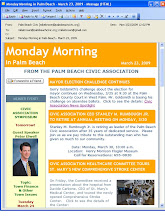How will item-level intelligence be used to market products?
We all know Radio Frequency Identification (RFID) will help with the supply chain (inventory) and with security in stores (reducing shoplifting and employee theft).
I think it will be the backbone of retail inventory-security-transaction-merchandising integration - and online integration into the shopping experience.
The level of data that is possible and available from items and the systems that track them will have a huge impact:
- On how those items are linked to purchasers, purchase trends, and forecasting
- Direct marketing by manufacturers and retailers which means one-to-one marketing instead of one-to-many marketing
- How retailers organize and build their stores and the shelves that hold both the product and the systems to track product location
- Create real-time on-the-shelf negotiations possible (e-coupons) with a consumer and their smartphone
- Make transactions without a cash register or human intervention
- Direct offline and online interaction with a manufacturer or distributor and change merchandising into an IP based experience. When a consumer is in a store, they will be able to use their smartphone to link to a product and a mobile website (.mobi) and find out more about it, how it’s used, the benefits, even customer testimonials – yes with video!
- Implications for a consumer's home inventory. Bet you didn’t know you had one. It’s called a shopping list.
Plus many other areas of marketing using RFID....
Item-level intelligence is being used today by the US government, the US Defense Department, Homeland Security, airports, and some bigger industries. It’s still in the early adopter stage.
Stay tuned. From time to time I’ll update you on where this is and where it’s going.
SMART Marketing and PR
S = Strategy to Meet Goals
M = Media Mix
A = Art & Creative that Sells
R = Research to Identify Buyers and Measure the Results for ROI
T = Tactics & Channels that Fit the Situation
M = Media Mix
A = Art & Creative that Sells
R = Research to Identify Buyers and Measure the Results for ROI
T = Tactics & Channels that Fit the Situation
Friday, July 18, 2008
Monday, July 14, 2008
Congressional Hearing on Item-Level Intelligence
WHAT: A congressional briefing, "Making Dollars and Sense: U.S. Radio Frequency Identification (RFID) Companies, the Global Market and the U.S. Government"
WHERE: Hart Senate Office Building, Room 902
WHEN: Thursday 17 July, 12:30 p.m. to 2
PANELISTS: Jeff Harris, Alien Technology Corporation; Kevin Kali, EPC Solutions, Inc.; Peter Kuzma, Thin Battery Technologies, Inc.; Paul Rudolf, Arnold & Porter, LLP; and James Clark (moderator), XIO Strategies.
Sen. John Cornyn (R-Texas), who co-chairs the Senate RFID Caucus with Sen. Byron Dorgan (D-N.D.), is scheduled to speak at 12:30.
SPONSORS: IEEE-USA, the International RFID Business Association and the RFID Technology Council ( http://www.rfidtechcouncil.org/) are sponsoring the briefing.
WHY ATTEND: To learn more about the pluses and challenges U.S. RFID companies face in the global marketplace from a panel of experts whose companies use and market RFID-based products
RFID is one of a group of automatic identification technologies that includes bar codes, optical character readers, smart cards like those used in mass transportation and express toll lanes, and some biometric technologies, among others. RFID technology has many applications, a few of which include health care, supply chain management and homeland security.
Unlike bar codes, RFID doesn't require line-of-sight reading, and information can be exchanged at greater distances.
WHERE: Hart Senate Office Building, Room 902
WHEN: Thursday 17 July, 12:30 p.m. to 2
PANELISTS: Jeff Harris, Alien Technology Corporation; Kevin Kali, EPC Solutions, Inc.; Peter Kuzma, Thin Battery Technologies, Inc.; Paul Rudolf, Arnold & Porter, LLP; and James Clark (moderator), XIO Strategies.
Sen. John Cornyn (R-Texas), who co-chairs the Senate RFID Caucus with Sen. Byron Dorgan (D-N.D.), is scheduled to speak at 12:30.
SPONSORS: IEEE-USA, the International RFID Business Association and the RFID Technology Council ( http://www.rfidtechcouncil.org/) are sponsoring the briefing.
WHY ATTEND: To learn more about the pluses and challenges U.S. RFID companies face in the global marketplace from a panel of experts whose companies use and market RFID-based products
RFID is one of a group of automatic identification technologies that includes bar codes, optical character readers, smart cards like those used in mass transportation and express toll lanes, and some biometric technologies, among others. RFID technology has many applications, a few of which include health care, supply chain management and homeland security.
Unlike bar codes, RFID doesn't require line-of-sight reading, and information can be exchanged at greater distances.
Labels:
marketing technology,
regulation,
RFID
Item-Level Intelligence
You’re going to hear a lot more in the near future about “item-level intelligence.” This technology puts electronics: transistors, transmitters, etc. into ink that can be printed on everything.
Right now 30 million transistors can fit on the head of a pin. So including the electronics you need to attach to any item you want using ink isn’t hard to imagine. Bye-bye barcodes!
I worked on presenting Radio Frequency Identification (RFID) as a future technology when I was at Motorola in 2001. It’s now a reality.
A Simple Example
Think about a consumer package good like a can of beans. The manufacturer puts the beans in a can and a printed label is put on the can. The ink on the label has transistors and transmitters in it so the bean manufacturer knows what ‘s in the can, the date of manufacture, and where the can has to go. The company that ships the can knows where the can is. The company that bought the beans knows when it gets to the warehouse and what store it is supposed to go to, and when it arrives. The store knows when it got on the shelf, AND WHEN A CUSTOMER PICKS IT UP TO LOOK AT IT, or buys it.
Thought that would grab you. Ink based paper antennas are positioned at the end of each aisle so the merchandising system can keep track of where the beans are moved (stop it).
Item-level intelligence brings a whole new meaning to Just-in-Time manufacturing and the entire supply chain. What does this mean for marketing?
You can negotiate with a buyer right at the shelf. Don’t want to advertise the beans? Try a coupon strategy just like they do now. Instead of having tags on the shelf under the beans, when a customer checks out the beans by picking them up and looking at them, the system can offer a coupon to the buyer’s opt-in smart phone when the buyer puts the can back on the shelf. It might make the buyer reconsider.
Benefits to buyers are a way to budget, reduce costs of goods, find them, and create a shopping list that is managed on their phone. Need milk? You’ll know if your garbage can has an RFID antenna. When you throw the milk carton in the garbage, your shopping list gets updated. You see the benefits.
Item-level intelligence will offer in depth data on products, sales, segment penetration and analytics, and will finally allow one-to-one marketing at the residence and shelf level.
Keep an eye out here for more on this emerging marketing technology.
Right now 30 million transistors can fit on the head of a pin. So including the electronics you need to attach to any item you want using ink isn’t hard to imagine. Bye-bye barcodes!
I worked on presenting Radio Frequency Identification (RFID) as a future technology when I was at Motorola in 2001. It’s now a reality.
A Simple Example
Think about a consumer package good like a can of beans. The manufacturer puts the beans in a can and a printed label is put on the can. The ink on the label has transistors and transmitters in it so the bean manufacturer knows what ‘s in the can, the date of manufacture, and where the can has to go. The company that ships the can knows where the can is. The company that bought the beans knows when it gets to the warehouse and what store it is supposed to go to, and when it arrives. The store knows when it got on the shelf, AND WHEN A CUSTOMER PICKS IT UP TO LOOK AT IT, or buys it.
Thought that would grab you. Ink based paper antennas are positioned at the end of each aisle so the merchandising system can keep track of where the beans are moved (stop it).
Item-level intelligence brings a whole new meaning to Just-in-Time manufacturing and the entire supply chain. What does this mean for marketing?
You can negotiate with a buyer right at the shelf. Don’t want to advertise the beans? Try a coupon strategy just like they do now. Instead of having tags on the shelf under the beans, when a customer checks out the beans by picking them up and looking at them, the system can offer a coupon to the buyer’s opt-in smart phone when the buyer puts the can back on the shelf. It might make the buyer reconsider.
Benefits to buyers are a way to budget, reduce costs of goods, find them, and create a shopping list that is managed on their phone. Need milk? You’ll know if your garbage can has an RFID antenna. When you throw the milk carton in the garbage, your shopping list gets updated. You see the benefits.
Item-level intelligence will offer in depth data on products, sales, segment penetration and analytics, and will finally allow one-to-one marketing at the residence and shelf level.
Keep an eye out here for more on this emerging marketing technology.
SMART Marketing and PR
Marketing and PR that is integrated and SMART will get more leads, more traffic, and grow a business faster than other systems:
S = Strategy to Meet Goals
M = Market Channels
A = Art & Creative that Sells
R = Research to Identify Buyers and Channels
T = Tactics That Fit the Situation
S = Strategy to Meet Goals
M = Market Channels
A = Art & Creative that Sells
R = Research to Identify Buyers and Channels
T = Tactics That Fit the Situation
Subscribe to:
Posts (Atom)







